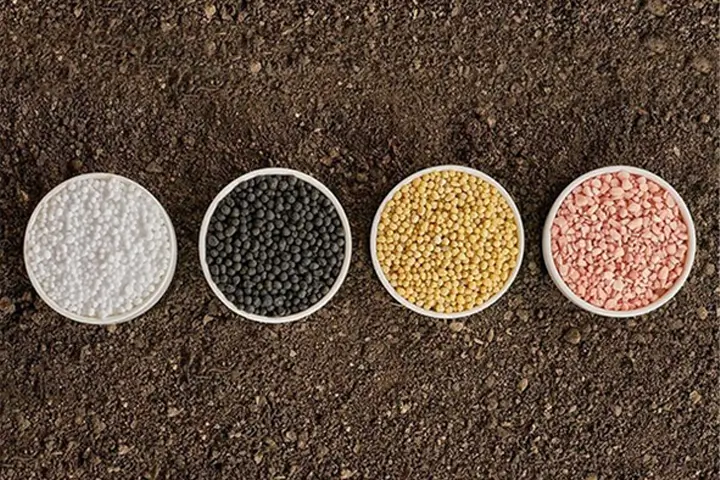
Fertilizers are substances or mixtures applied to soil or plants to provide essential nutrients that support plant growth and increase crop yields. They replenish nutrients in the soil that are naturally depleted through plant uptake and leaching. Fertilizers typically contain nitrogen (N), phosphorus (P), and potassium (K), known Macronutrients and other micronutrients necessary for plant development, growth, flowering, productivity and higher Harvest yielding.
Here are the main types of fertilizers:
1. Nitrogen-based fertilizers: Nitrogen is crucial for plant growth and is required in large quantities. Nitrogen fertilizers include ammonium nitrate, urea, ammonium sulfate, and calcium ammonium nitrate. They provide nitrogen in a form that plants can readily absorb.
2. Phosphorus-based fertilizers: Phosphorus promotes root development, flowering, and fruiting. Common phosphorus fertilizers include superphosphate, triple superphosphate, and diammonium phosphate. They provide phosphorus in a form that is accessible to plants.
3. Potassium-based fertilizers: Potassium helps with overall plant health, water regulation, and fruit quality. Potassium fertilizers include potassium chloride, potassium sulphate, and potassium nitrate. They supply potassium ions for plant uptake.
4. Compound fertilizers: These fertilizers contain a combination of nitrogen, phosphorus, and potassium, often in specific ratios. Examples include NPK (nitrogen, phosphorus, potassium) fertilizers like 10-10-10 or 20-10-5, where the numbers represent the percentage of each nutrient in the fertilizer.
5. Organic fertilizers: Organic fertilizers are derived from natural sources, such as compost, animal manure, bone meal, fish emulsion, and seaweed extracts. They improve soil structure and provide a slow release of nutrients over time.
6. Slow-release fertilizers: These fertilizers release nutrients gradually over an extended period, reducing the risk of nutrient leaching and ensuring a steady supply for plants. They are often coated or encapsulated to control nutrient release.
7. Liquid fertilizers: These fertilizers come in liquid form and are dissolved in water for application. They can be synthetic or organic and are often used for foliar feeding or through irrigation systems.
The main difference between fertilizers and bio inputs lies in their composition and mode of action:

- Fertilizers: Fertilizers are substances or mixtures that contain essential nutrients necessary for plant growth. They are typically synthetic or mineral-based compounds that provide specific nutrients like nitrogen, phosphorus, and potassium to the plants. Fertilizers are designed to replenish nutrient levels in the soil and promote plant growth and development. They are primarily focused on supplying macronutrients and micronutrients to plants in readily available forms. Fertilizers can be either organic or inorganic.
- Bio Inputs: Bio Inputs, on the other hand, are products derived from natural sources, such as plants, animals, and microorganisms, and are used to enhance plant health and improve crop productivity. Bio Inputs include a wide range of products, such as biofertilizers, bio stimulants, biopesticides, and microbial inoculants. They work through various mechanisms, including improving soil fertility, enhancing nutrient uptake, stimulating plant growth and stress tolerance, and promoting beneficial interactions between plants and microorganisms. Bio Inputs are generally considered to be more sustainable and environmentally friendly compared to synthetic fertilizers.

Fertilizers primarily focus on providing essential nutrients to plants, while bio inputs encompass a broader range of products derived from natural sources that promote plant health, growth, and productivity through various mechanisms beyond nutrient supply. Bio Inputs are often seen as a more sustainable and ecologically friendly alternative to synthetic fertilizers, as they harness natural processes and interactions to enhance agricultural practices.
It’s important to note that the choice of fertilizer depends on factors such as soil type, plant requirements, and specific nutrient deficiencies. It’s recommended to conduct soil tests and consult local agricultural experts to determine the appropriate type and application rate of fertilizers for specific crops or plants.
Written by ANIL MATHEW VARGHESE ORGANIL SERVICES (REGISTERED & DEDICATED ORGANIC CERTIFICATION CONSULTANCY) MOBI # +91-8606551335 OR orgnil40@gmail
Stay updated with the latest farming tips and agriculture industry news from Africa by subscribing to our newsletter. Don’t miss out on valuable insights and updates. Follow us on Twitter, LinkedIn, and Facebook to join our farming community and stay connected with us.



















